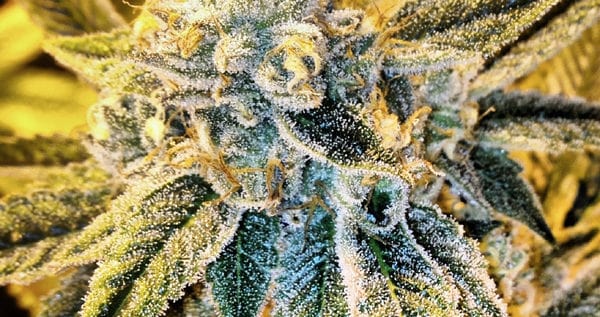
The Cornbread strain inspires the feeling of maximum relaxation and calm – like you just finished scarfing down a plateful of southern comfort food. That’s because this variety doesn’t just wade in the indica end of the genetic pool – it’s dominated by the predisposition with a 4 to 1 ratio. So what you get is a deep, heavy blanket of calm that covers the system from head to toe. The subduing benefits might just push you to lie down, take a load off, and snooze into dreamland.
As the perfect appetizer, the Cornbread herb awakens the physiological need to munch. With a complex cannabinoid profile that urges the stomach to churn and grumble, the Cornbread cannabis cultivar is a favorite among users who just can’t seem to find the gusto for mealtime.
Currently, Corbread is still hurdling the upward climb towards worldwide popularity. But with a superstar parent like Bubba Kush, it’s really just a matter of time before this herb takes off into cannabis industry celebrity status. It’s other parent – another little-known herb – comes in the form of Rare Dankness #2. Both ancestors tout indica-dominant genetics, which mainly explains how the Cornbread cultivar inherited such strong tranquilizing effects.
But other than that, Cornbread also takes after Bubba Kush when it comes to flavor. The offspring perfectly encapsulates its parent cultivar’s lemon overtone, with bitter notes of coffee and dark chocolate finding refuge under the tongue. Bubba Kush’ heavy, dreamy euphoria also shines through the Cornbread’s genetics, weighing down the body with its sedative effects.
Rare Dankness #2 – despite being relatively unknown – brandishes incredibly powerful indica-leaning effects. Mostly, its lack of market presence and popularity is a result of its rarity – as its name suggests. But had there been a more generous supply circulating the industry, the sleep-inducing herb would have likely found itself an avid following.
Cornbread comes in the form of chunky, bite-sized nugs. The delicate samples are relatively smaller than many of the other varieties you’ll find, but they’re not any less decorated. Splashed across the surface are deep greens and blues, sometimes deepening further to a full on purple. All over stubby little nugs are dense networks of hairs that almost completely blot out the leaves underneath. These gentle tendrils make the herb especially compact, even helping to reduce fall out and break off.
The first time you stuff your nose into a jar of Cornbread, you’re likely to be greeted with the aroma of citrus. The overpowering sourness is tailed closely by notes of bitterness, transforming into the distinct taste of coffee and sugar-free chocolate down the line. Immerse yourself in the oflactory encounter, and you’d probably detect a few other elements in the mix. Hints of pine, mint, wood, and gasoline sway in unison as undertones, making the strain a total hodge podge of scents, producing a dynamic, multi-faceted aroma.
When stuffed into a bowl, lit, and dragged, Cornbread’s dynamic fragrance becomes a dichotomy. As smoke, the cultivar tastes more like a fusion citrus and gasoline which both battle it out to dominate your taste buds. In the end, no one really wins. But the pointless tug-of-war can preoccupy your cognition as the strain gets to work in the background.
As your eyelids start to droop and your breathing slows down to a steady, relaxed pace, the complex chemistry of cannabinoids fires up your appetite. A sudden hankering for whatever food you can stuff down your chomper becomes the central thesis of the entire encounter. For that reason, it would be best to make sure you’ve got a well-equipped pantry before you decide to take a toke of this specific herb.
Once you satisfy your stomach kraken, your one-track mind moves on to shift its focus on relaxation. With the strain’s chemistry blurring out discomfort, your body feels compelled to take a load off and call it a day – best be sure you don’t have any other obligations lined up.
Ideal for the novice farmer, Cornbread makes a seasoned cultivator out of even the worst gardeners. The strain is hardy, resilient, and fast to finish, bringing you the bounty of its harvest in under 2 months. Size-wise, its medium-tall shrub size makes it suitable for both outdoor and indoor cultivation. If you’ve got limited indoor space, the herb doesn’t really take up too much room, so you can comfortably grow the bud without cramping up your living area.
If you’re dabbling with cannabis-derived CBD products and you’re interested in manufacturing your own, Cornbread may be a viable raw material. Using the strain means producing indica leaning formulations, like edibles and tinctures, that focus on relaxation rather than awakening the senses. In many cases, individuals who struggle with their appetite might find excellent purpose in having a Cornbread concentrate in their pocket for those moments when their hunger is just nowhere to be found.
Like a kindly old southern mother who takes care of your hunger and gives you a place to rest, the Cornbread strain maintains its focus on making sure you get the nutrition and rest you need. The herb is hailed for its incredible effect on physiological functions, helping you combat the negative effects of lowered mood and decreased motivation. So, if you’re dealing with a loss of appetite, or if you simply want to enjoy uninterrupted sleep, then Cornbread should find a place in your stash.
For farmers, the easy growth requirements for the variety prove it to be an effortless choice. Short, stubby, and generous with its returns, Cornbread can be rewarding to grow whether you’re a recreational cultivator or a budding business owner. If you’re interested in going the extra mile, Cornbread’s almost pure indica genetics produce ultra-potent concentrates and extracts that perfectly encapsulate the relaxing powers of cannabis.
[starbox id=3]